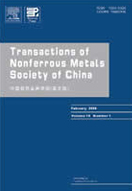Interfacial structure of steel-Al-28Pb bonding plate
with semisolid rolling-casting method①
with semisolid rolling-casting method①
(1. Department of Mechanical Engineering, Beijing Jiaotong University,
Beijing 100044, China;
2. Department of Mechanical Engineering, Tsinghua University, Beijing 100084, China;
3. Metal Forming Department, Northeastern University, Shenyang 110006, China;
4. Anshan Automobile Fittings Factory, Anshan 114014, China)
Beijing 100044, China;
2. Department of Mechanical Engineering, Tsinghua University, Beijing 100084, China;
3. Metal Forming Department, Northeastern University, Shenyang 110006, China;
4. Anshan Automobile Fittings Factory, Anshan 114014, China)
Abstract: Fe-Al compound at the interface of steel-mushy Al-28Pb bonding plate was studied quantitatively. The relationship between ratio of Fe-Al compound at interface and bonding parameters such as preheating temperature of steel plate, solid volume fraction of Al-28Pb slurry and rolling speed, was established by artificial neural networks perfectly. The results show that when the bonding parameters are 546℃for preheating temperature of steel plate, 43.5% for solid
volume fraction of Al-28Pb slurry and 8.6 mm/s for rolling speed, the reasonable ratio of Fe-Al compound corresponding to the largest interfacial shear strength of bonding plate is obtained as 71.5%. This reasonable ratio of Fe-Al compound is a quantitative criterion of interfacial embrittlement, that is, when the ratio of Fe-Al compound at interface is larger than 71.5%, interfacial embrittlement will occur.
volume fraction of Al-28Pb slurry and 8.6 mm/s for rolling speed, the reasonable ratio of Fe-Al compound corresponding to the largest interfacial shear strength of bonding plate is obtained as 71.5%. This reasonable ratio of Fe-Al compound is a quantitative criterion of interfacial embrittlement, that is, when the ratio of Fe-Al compound at interface is larger than 71.5%, interfacial embrittlement will occur.
Key words: interfacial structure; Fe-Al compound; artificial neural networks

